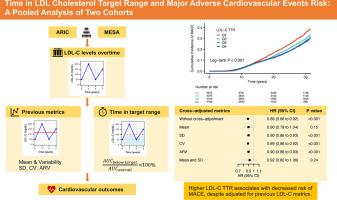低密度脂蛋白胆固醇目标范围时间和主要不良心血管事件风险:两个队列的汇总分析
IF 5.9
Q1 CARDIAC & CARDIOVASCULAR SYSTEMS
引用次数: 0
摘要
低密度脂蛋白胆固醇(LDL-C)的传统管理依赖于单点测量,而忽略了长期水平和暴露于高LDL-C的持续时间。本研究旨在评估两个美国队列中LDL-C目标范围内时间(TTR)与主要不良心血管事件(MACE)风险之间的关系。方法本研究是对社区动脉粥样硬化风险(ARIC)研究和多民族动脉粥样硬化研究(MESA)队列的二次分析。LDL-C TTR定义为LDL-C值低于100 mg/dL的曲线下面积相对于前4次就诊总面积的百分比。使用调整后的Cox模型和Fine-Gray竞争风险模型估计LDL-C TTR与MACE之间的关联。结果在平均21.2±8.1年的随访中,16310名参与者发生了3306例MACE。最高LDL-C TTR四分位数与MACE降低25% (HR: 0.75, 95% CI: 0.68至0.83),心肌梗死降低42% (HR: 0.58, 95% CI: 0.49至0.68),卒中降低24% (HR: 0.76, 95% CI: 0.64至0.91),CVD死亡降低13% (HR: 0.87, 95% CI: 0.76至1.00;临界意义)相关。在调整了平均LDL-C或LDL-C变异性后,TTR仍然与MACE显著相关,并且在竞争风险分析中具有很强的相关性。在预后价值方面,TTR也优于LDL-C均值和LDL-C变异性(Akaike信息标准,c -统计)。结论sldl - c TTR独立预测MACE,并可能提供比平均水平或变异性更全面的长期LDL-C控制评估,支持其潜在的临床应用。本文章由计算机程序翻译,如有差异,请以英文原文为准。

Time in LDL cholesterol target range and major adverse cardiovascular events risk: A pooled analysis of two cohorts
Background
Traditional management of low-density lipoprotein cholesterol (LDL-C) relies on single-point measurements, neglecting long-term magnitude and the duration of exposure to elevated LDL-C over time. This study aimed to evaluate the association between LDL-C time in target range (TTR) and the risk of major adverse cardiovascular events (MACE) in two US cohorts.
Methods
This study was a secondary analysis of the Atherosclerosis Risk in Communities (ARIC) study and the Multi-Ethnic Study of Atherosclerosis (MESA) cohorts. LDL-C TTR was defined as the percentage of the area under curve for LDL-C values below 100 mg/dL relative to the total area over the first 4 visits. Association between LDL-C TTR and MACE was estimated using adjusted Cox models and Fine-Gray competing risk models.
Results
Over a mean follow-up of 21.2 ± 8.1 years, 3306 MACE occurred among 16,310 participants. The highest LDL-C TTR quartile was associated with a 25 % reduction in MACE (HR: 0.75, 95 % CI: 0.68 to 0.83), 42 % reduction in myocardial infarction (HR: 0.58, 95 % CI: 0.49 to 0.68), 24 % reduction in stroke (HR: 0.76, 95 % CI: 0.64 to 0.91), and 13 % reduction in CVD death (HR: 0.87, 95 % CI: 0.76 to 1.00; borderline significance). TTR remained significantly associated with MACE after adjusting for mean LDL-C or LDL-C variability, and were robust in competing risk analyses. TTR also outperformed mean LDL-C and LDL-C variability in prognostic value (Akaike information criterion, C-statistics).
Conclusions
LDL-C TTR independently predicts MACE and may offer a more comprehensive assessment of long-term LDL-C control than mean levels or variability, supporting its potential clinical utility.
求助全文
通过发布文献求助,成功后即可免费获取论文全文。
去求助
来源期刊

American journal of preventive cardiology
Cardiology and Cardiovascular Medicine
CiteScore
6.60
自引率
0.00%
发文量
0
审稿时长
76 days
 求助内容:
求助内容: 应助结果提醒方式:
应助结果提醒方式:


